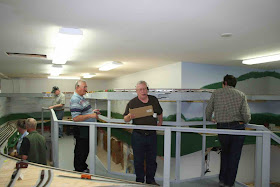A current
discussion among layout designers concerns holding and sorting slots for car
cards used to direct freight car movements on model railroads. I described my basic car card slots in a post
two years ago. http://espeecascades.blogspot.com/2014/05/car-card-boxes.html
Since that time, I have put my railroad
into full operations and done a fair bit of labeling. Further, I just introduced new
computer-printed waybills and the “Spot Card” concept. http://espeecascades.blogspot.com/2016/05/improved-car-movement-documents.html Given the current on-line discussion, a
refreshed visit to this topic is in order.
As I previously
noted, I build my car card boxes with a nominal 1x3 MDF molding for the front
piece. Most of my boxes use nominal ½ x
2 wood strip for spacer-separators.
Though this might seem wide by some, I have found the extra thickness of
the spacer makes for easier handling of the cards by my fat fingers and better
visual separation of the groups of cards in the slots. I use 1/8 hardboard as a backing. This is a bit shorter than the height of the
cards, providing for a finger-hold for the car cards in the slots.
A key reason for
the thick front piece is to provide a horizontal surface for slot labels. I got this idea from Rob Spangler in
descriptions of his WP 8th Sub layout on the Model Railroad Hobbyist
Forum. The horizontal labels are easily
viewed from the normal operator standing position.
Car Card slot
boxes on fascia shelves at Eugene Yard.
Yard track car
card box with slots for each track.
In the picture
above, the yardmaster has begun assembling blocks of cars on three
classification tracks for three of the locals that originate at Eugene. Slot file separators are available for the
yardmaster to identify the use of each track and groups of car cards associated
with the blocks of cars on those tracks.
The yardmaster
also has a stack of “Spot Cards” for each of those locals. The spot cards are used to control the number
of cars sent out to each industry spur.
A high proportion of the traffic on my railroad is for empties delivered
to industries for outbound loading. One
can think of the spot cards as a form of the station agent’s call for
empties. This reinforces the waybills,
which also represent industry demand.
Each day, the car clerk (usually me during staging) collects up the spot
cards from the cars at industries that are to be picked up. These are added to the spot card stack at
Eugene. All the yardmaster needs to know
is that if a car is billed for an industry and has a spot card, there will be
space at that industry and the car can be sent out on the next local serving
that station.
Inbound loads
might arrive on any mainline freight arriving at Eugene. The yard needs to pull those cards into the
classification yard and add them to the car block for the appropriate
local. There is more variability in
dealing with these inbound cars, so the spot cards help control what goes out
on the locals. The result is the use of
Eugene for excess traffic—the “off-spot” cars.
Since my waybill deck is quite new, I have not had time to balance the
traffic contained therein, so it is quite easy to overload a few of the
industry spurs. The spot cards help
control this flow.
Example cars
with car cards containing both waybill and spot card. These cars are ready to go out to Oakridge on
the next Oakridge Turn.
Cars at
Springfield ready for pick up. The spot
cards have been removed and the waybills cycled toward the next destination.
As the photos
show, I use a car card slot for each track, spur or industry. That last case provides three separate card
slots for the three industries along one spur at Eugene. My other industry spurs get a single slot
each, even when one industry has a couple of tracks, such as Western Lumber at
Westfir.
Car Card slots
at Westfir. Western Lumber has two
tracks. The front track serves the wood
chip loader and the plywood warehouse.
The back track serves the lumber loading. A spare slot has been provided for a possible
future use.
My car card slot
boxes rest on the 1x4 shelves at the base of the layout fascia. For some layouts, the shelf extension into
the aisle might be an issue. I have been
careful placing the fascia shelves to minimize their impact on human traffic
flow. The railroad was designed with
fairly wide aisles, though I did compromise down to a standard three feet wide
aisle minimum around much of the mainline.
The Eugene-Springfield area has a very generous aisle that squeezes down
to six-feet wide at the Springfield turn-back loop, but broadens to eight feet
wide at the blind end near the Willamette River crossing at RR-West Eugene
(RR-East Springfield). I carefully
thought through the human traffic around the rest of the railroad. So far, this seems to work acceptably, though
there are occasions when operators must pass each other. Aisle width is an important element of layout
design. Projections into that aisle,
such as my operator shelves and card card boxes, must be considered as part of
that overall design. It is not all track!












